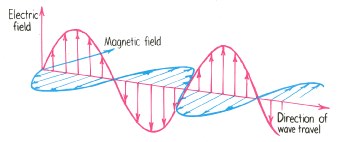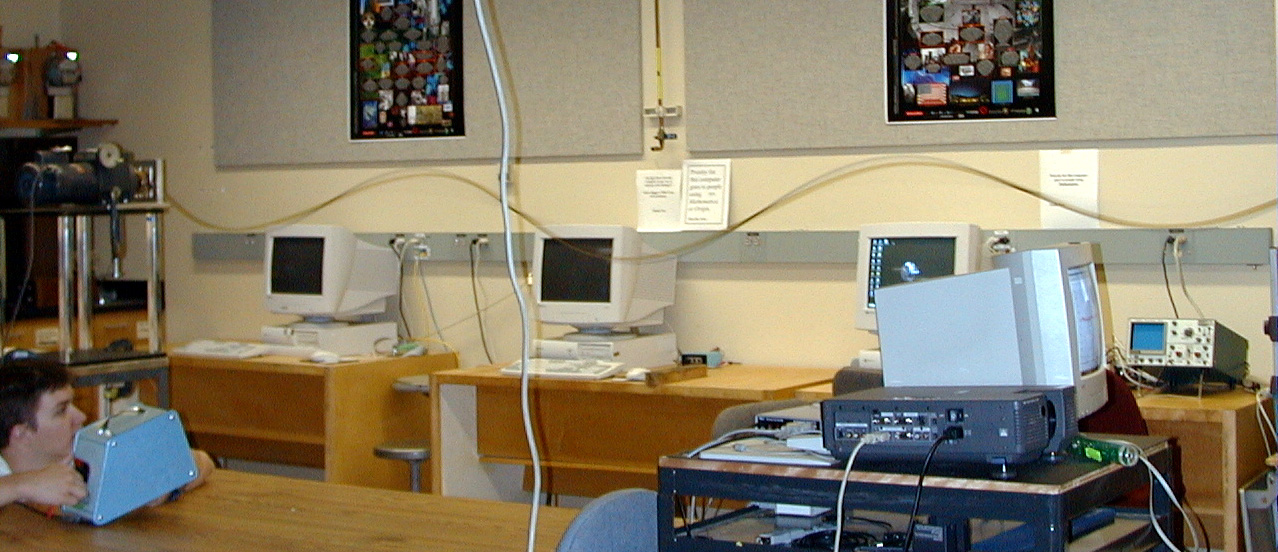![]()
Essentials of Physics- PHYS 101
Lecture 15/16
![]()
![]()
Average score for the exam was 21 points out of 32, or about 66%.
- Let's go through some problems and figure out the answers.
- Link exam results and answers.
Electric Motors
Magnets can exert forces on one another. One can construct a permanent magnet as shown below. The magnetic field lines connect the magnet's "south" pole to its north.
Now place a current-carrying coil of wire so that its magnetic field interacts with the permanent magnet. In general, the fields of the two magnets (permanent and coil) will try to line up with one's south pole near the other's north (and vice versa).
If we did nothing else to our prototype electric motor, it would NOT WORK! What keeps our motor spinning? We use a special switch, called a commutator, and brushes to reverse the direction of the coil's magnetic field every half-turn. Once the coil's south pole is near the permanent magnet's north, we switch the direction of the current through the coil. This reverses the coil's magnetic field. Now the coil's north field is near north of the permanent magnet, so they repel. This keeps the coil rotating.
Thus we build our motor. Things that control the useful power we get out of an electric motor are:
- number of windings in coil/armature, more windings give a stronger magnetic field.
- (magnetic field) strength of permanent magnets.
- area of the coil (larger area results in a stronger field.
- multiple coils inside motor.
- (look familiar?)

Electromagnetic Induction
- If moving (e.g., spinning or orbiting) charge results in magnetism, can a magnet be manipulated to move charge? Let's look at the Lenz's Law demonstration.

- It appears that a changing magnetic field can cause charge to move. More specifically, the changing magnetic field creates a voltage (charge push) which can cause current to flow. We can have that electric current flow through a circuit and do useful work for us.

Changing Fields Instead of Moving Charges
- A changing magnetic field is shown to induce charge to move along a wire. What if the wire is taken away? What is left?
- Even without the wire, a changing electric field still remains. How do we know this? Put the wire back in and the changing electric field will push or pull charges along it. Faraday's law describes this phenomenon:
- An electric field is induced in any region of space in which a magnetic field is changing with time. The magnitude of the induced electric field is proportional to the rate at which the magnetic field changes (faster change gives stronger electric field). The direction of the induced electric field is at right angles (perpendicular) to the changing magnetic field. (shamelessly stolen from Conceptual Physics, by Hewitt)
- The charge moving along the wire was shown to create another magnetic field (remember when the wire jumped out from between the magnets?). If the moving charge changed (current varied), the magnetic field it generated also varied. What happens when we take away the wire? The varying electric field creates a varying magnetic field! This is one of Maxwell's laws:
- A magnetic field is induced in any region of space in which an electric field is changing with time. The magnitude of the induced magnetic field is proportional to the rate at which the electric field changes. The direction of the induced magnetic field is at right angles to the changing electric field. (ditto)
- And now we're back to square one. The changing magnetic field induces a changing electric field, which in turn induces a changing magnetic field. This is the way light, radio, x-rays, micro, ultraviolet and infrared waves travel through empty space!

![]()
Some questions about waves:
What are the sources of waves
Typically waves arise from oscillating objects, things that are going back and forth... and back and forth. An example is a vibrating guitar string, which is the source of a sound wave.
Do waves involve the transport of material? If not, what IS transported
Waves do NOT involve the net transport of material in the direction of wave travel. The air that supports a sound wave doesn't travel from the speaker to the listener, for example. What is transported? ENERGY!
What do waves look like
In general there are two types of waves: transverse and longitudinal.
Transverse waves:
- medium is displaced perpendicular to the direction the wave travels.
- Examples: guitar strings, seismic "shear" waves, water waves, light.
Longitudinal waves:
- medium is displaced (but NOT transported) in the direction of the wave.
- Examples: sound waves, seismic "P" waves.
So what kind of wave is an electromagnetic wave
How do we otherwise describe waves
We describe waves in terms of these concepts:
wavelength:
period:
frequency:
...... by the way:
and wave speed:
And there's a relationship between a wave's speed, wavelength and frequency.... (uh, let's see, speed is wavelength's illegitimate child by frequency's brother....)
No, its:
So, what am I looking at here

Speed of Sound
- Sound travels at different speeds through different materials. Why?
- Why was Tonto always putting his ear to the ground?
- The speed of sound in 20oC air is about 340 m/s (0.21 mi/s). Is it faster or slower in warmer air? Why?
- Why does sound bend? Why do I hear the train so loudly some nights?
- What causes sound to reflect?
- Comparison of speed of sound in air to speed of light.
- How far away was that lightning?
Interference & Standing Waves
You may have noticed that multiple water waves can "occupy the same space." That is, a short, narrow wave can ride on a large swell in the ocean.
We call this phenomenon interference. Waves can superpose (add together) on one another. Then interesting things can happen. Consider two waves of equal wavelength and frequency. Further, both waves interfere, and both start at exactly the same time. The result will be a wave of twice the amplitude. This is called constructive interference.
Now consider shifting the starting point of one of those waves by 1/2 wavelength. The sum of these two waves will be zero. This is called destructive interference. If these two waves are sound waves, you won't hear anything!
- Let's try this out with the old stereo!

Resonance
- What happens when an oscillator is driven? More importantly, what happens when it is driven with just the right frequency?
- How do you use resonance every day?
- What happens to resonance frequencies when the length of the resonator changes? What happens when the speed of sound changes? Why do you sound like Donald Duck if you breathe helium?
- Build your own clarinet from a straw!

Doppler Effect
- Have you ever waited for a train to cross and notice how the sound of its "whistle" changes?
- This is called the doppler effect. It is caused because the sound source, the train in this case, is first moving towards you and then away from you.
